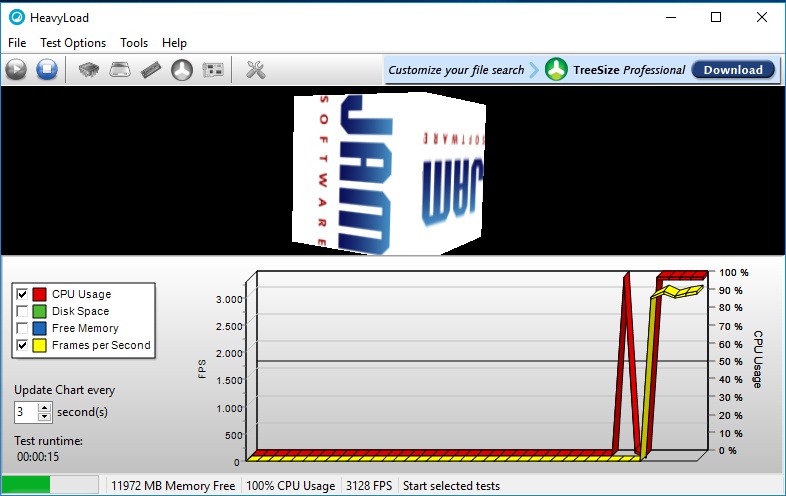How to Stress-Test CPUs and PCs (Like We Do)
System: AIDA64, powerMAX & Heavy Load
AIDA64 With FPU & GPU
The problem with AIDA64’s combined CPU and GPU stress test is that, even though it effectively isolates the performance of specific subsystems, the ratio of CPU and GPU load just isn’t right. This makes the test unrealistic. Adding up all of the individual loads to achieve a generally taxing scenario might provide some useful information, but we've already discussed better alternatives for the same type of task.
Even if the Stress CPU, Stress System Memory, and Stress GPU(s) settings are all activated at once, AIDA64’s efforts still fail to yield a realistic workload.
| Header Cell - Column 0 | CPU Package(PECI) | Core Average | SensorSocket | GPUDiode | CPU(Watts) | GPU(Watts) | System (Watts) |
|---|---|---|---|---|---|---|---|
| Measurement | 84°C | 83°C | 96°C | 61°C | 150W | 86W | 307W |
| Compared to Maximum | 98.8% | 97.6% | 92.3% | 95.3% | 88.8% | 85.1% | 86.0% |
| Assessment | High package temperatureVery high socket temperatureAverage memory temperatureBelow game-level GPU power consumptionMuch higher than game-level CPU and system power consumption | ||||||
| Use for | Not really suitable for combined stress testing |
powerMAX With AVX Or SSE & GPU
powerMAX wasn’t one of our top contenders when it came to GPU stress testing. Can it redeem itself through the addition of an integrated CPU stress test? We run both versions again in order to find out what powerMAX does well. The GPU workload remains windowed in order to avoid pushing the CPU stress test too far into the background. We also ensure the GPU stress test window is active.
powerMAX With AVX & GPU
powerMAX has the same problems as AIDA64: Its CPU load is way too high, while the graphics load is a little too low. This test is simple and convenient to run, but it just doesn’t provide balance. It’s not suitable for pushing your system to its limits, and it doesn’t simulate normal operation, either.
| Header Cell - Column 0 | CPU Package(PECI) | Core Average | SensorSocket | GPUDiode | CPU(Watts) | GPU(Watts) | System (Watts) |
|---|---|---|---|---|---|---|---|
| Measurement | 79°C | 79°C | 98°C | 62°C | 156W | 89W | 313W |
| Compared to Maximum | 92.9% | 92.9% | 94.2% | 96.9% | 92.3% | 88.1% | 87.0% |
| Assessment | Somewhat high package and core temperatureVery high socket temperatureSomewhat low memory temperatureBelow game-level GPU power consumptionMuch higher than game-level CPU and system power consumption | ||||||
| Use for | Not really suitable for combined stress testing |
powerMAX With SSE & GPU
Using the SSE code path shifts load from the CPU to the GPU. But that's not enough to simulate a realistic gaming scenario, and it’s not enough to push the system to its limits. Ultimately, our conclusions about this utility's AVX code path apply here as well.
| Header Cell - Column 0 | CPU Package(PECI) | Core Average | SensorSocket | GPUDiode | CPU(Watts) | GPU(Watts) | System (Watts) |
|---|---|---|---|---|---|---|---|
| Measurement | 69°C | 68°C | 82°C | 62°C | 130W | 90W | 280W |
| Compared to Maximum | 81.2% | 80% | 78.8% | 96.9% | 76.9% | 89.1% | 78.4% |
| Assessment | Somewhat lower package and core temperatureMedium socket temperatureSomewhat low memory temperatureBelow game-level GPU power consumptionMuch higher than game-level CPU and system power consumption | ||||||
| Use for | Not really suitable for combined stress testing |
Heavy Load With CPU & GPU
Heavy Load didn’t exactly inspire confidence in us when we tried its CPU and GPU tests on their own. As it turns out, combining two bad tests gets you another bad test. In fact, it’s completely unusable as either a stress or stability test, unless you want to be duped into believing an over-enthusiastic overclock will run stably under truly taxing loads.
| Header Cell - Column 0 | CPU Package(PECI) | Core Average | SensorSocket | GPUDiode | CPU(Watts) | GPU(Watts) | System (Watts) |
|---|---|---|---|---|---|---|---|
| Measurement | 58°C | 57°C | 59°C | 49°C | 100W | 34W | 186W |
| Compared to Maximum | 68.2% | 67.1% | 56.7% | 76.6% | 59.2% | 33.7% | 52.1% |
| Assessment | Very low package and core temperatureLow socket temperatureLow memory temperatureVery low GPU power consumption | ||||||
| Use for | Not suitable at all for combined stress testing |
MORE: Best CPUs For Gaming
Get Tom's Hardware's best news and in-depth reviews, straight to your inbox.
MORE: Intel and AMD Processor Benchmark Hierarchy Comparisons
MORE: All CPUs Content
Current page: System: AIDA64, powerMAX & Heavy Load
Prev Page System: MSI Kombustor & OCCT Next Page System: Measuring Power Consumption With Different Stress Tests
Igor Wallossek wrote a wide variety of hardware articles for Tom's Hardware, with a strong focus on technical analysis and in-depth reviews. His contributions have spanned a broad spectrum of PC components, including GPUs, CPUs, workstations, and PC builds. His insightful articles provide readers with detailed knowledge to make informed decisions in the ever-evolving tech landscape
-
WINTERLORD Is this like a fancy water cooler im guessing? what about a typical AIO cooler. In fact i have a skyth fuma but may save up to get some kind of AIO water cooling been tryin to find decent reviews on decent water coolers both cheap and if needed high end. not no alpha cooler though lolReply
Alphacool Eisblock XPX ($73.99 On Newegg)
Alphacool Eiszeit 2000 Chiller -
FormatC This is a high-end compressor cooler for up to 1500 watts heat input. It's a modified version from industry and mostly used to cool the head of powerful laser cutters. Why I'm using this one? To show, which program is able to do it right. If you have additionally limitations from coolers, thermal throttling and other funny things, you will never see the exact difference. I can keep a constant water temperature of 20°C to make all the test results comparable. ;)Reply -
Th_Redman What did you guys put on the hotdog after testing? A little mustard, ketchup, relish, sauerkraut...? LOL.Reply -
aquielisunari I use Aida, Prime 26.6, Superposition, UserBenchmark, MSI's kombustor and I no longer use Heaven. I may be forgetting a couple. But something has always felt a little off. I finally see what it was. My build was missing a hotdog and its bun. I always do love learning from the pros. I placed it on a piece of parchment and instantly I notice a difference.Reply
I routinely check temperatures, loads and other info from my system. I also stress test with different CPU and GPU benchmark/stress test software. Thanks for the info. Page bookmarked. -
CompuTronix As the author of the Intel Temperature Guide - http://www.tomshardware.com/forum/id-1800828/intel-temperature-guide.html - I can fully appreciate how much work went into creating this outstanding article, which has been sorely needed!Reply
Since most users test their rigs without a sense of scale for power and temperature, they can't compare apples to apples, especially when combined with major variables such as differences in ambient temperature, hardware configurations and software utilities. This article provides a perspective and some excellent comparisons.
The Intel Temperature Guide differs in its approach toward the topic of processor Core temperatures and cooling with respect to Intel's TDP specifications, and distinguishes between steady workloads for thermal testing versus fluctuating workloads for stability testing. Nevertheless, our results are very similar.
However, since Intel validates their thermal specifications at a steady 100% TDP, it's most appropriate to select utilities that don't overload or underload the CPU. The only utilities I've ever found that come as close as possible to 100% TDP are Prime95 v26.6 Small FFT's as a steady workload for thermal testing, and Asus RealBench as a fluctuating workload for stability testing.
Although the topic of Prime95 (with and without AVX) was covered, I would like to have seen RealBench included in your test suite,since it's widely accepted as an excellent utility for testing overall system stability, and uses a realistic AVX workload.
Otherwise, great work! I was very pleased to read this article!
CT :sol: -
cangelini Reply20741319 said:As the author of the Intel Temperature Guide - http://www.tomshardware.com/forum/id-1800828/intel-temperature-guide.html - I can fully appreciate how much work went into creating this outstanding article, which has been sorely needed!
Since most users test their rigs without a sense of scale for power and temperature, they can't compare apples to apples, especially when combined with major variables such as differences in ambient temperature, hardware configurations and software utilities. This article provides some excellent comparisons.
The Intel Temperature Guide differs in its approach toward the topic of processor Core temperatures and cooling with respect to Intel's TDP specifications, and distinguishes between steady workloads for thermal testing versus fluctuating workloads for stability testing. Nevertheless, our results are very similar.
However, since Intel validates their thermal specifications at a steady 100% TDP, it's most appropriate to select utilities that don't overload or underload the CPU. The only utilities I've ever found that come as close as possible to 100% TDP are Prime95 v26.6 Small FFT's for thermal testing, which is a steady workload, and Asus RealBench for stability testing, which is a fluctuating workload.
Although the topic of Prime95 (with and without AVX) was covered, I would like to have seen RealBench included in your test suite, as it's widely accepted as an excellent utility for testing overall system stability, and uses a realistic AVX workload.
Otherwise, great work! I was very pleased to read this article!
CT :sol:
That's an awesome resource, CT! -
WyomingKnott Reply20740696 said:What did you guys put on the hotdog after testing? A little mustard, ketchup, relish, sauerkraut...? LOL.
Thermal compound. Why not? People have used condiments between their CPUs and their coolers. -
FormatC Step 1 - Collect all what I need:Reply
Step 2 - Start the oven
Step 3 - Enjoy!
The benchmark:
The complete review was so funny, but it was never translated :(


